Plastic surgery is pervasive in our society. There’s some amazing results out there, but even celebrities can have something go wrong. We’ve all seen people with “frozen faces,” “pixie ears” or extremely large lips called the “trout pout.” Dr. Randal Haworth, MD, one of Southern California’s top plastic surgeons, is guest on this week’s West of Legal radio show. Dr. Haworth his own practice in Beverly Hills and is also on staff at Cedars Sinai Medical Center in Los Angeles. A specialist in facial surgery, rhinoplasty and breast augmentation, Haworth was one of two plastic surgeons who appeared on the hit Fox television reality show The Swan for two seasons. Attorney West Seegmiller talks with Dr. Haworth about the growth of the plastic surgery industry, the top procedures performed on men and women and the legal issues involved when something goes wrong. Listen to the West of Legal show every Sunday at 1 p.m. on KFWB News Talk 980.
Category: Press & Media
YAHOO! CONT. NETWORK OCT 30TH (2011) – LEAVE IT TO VANITY FAIR AND WEST HOLLYWOOD TO MAKE A LIBRARY HIP! WITH THE ART GENIUS OF SHEPARD FAIREY AND MORE!
Vanity Fair and Cadillac, in Partnership with MOCA Create “The West Hollywood Library Murals.” Artists Shepard Fairey, Retna, and Kenny Scharf Bring Art to the Streets of Los Angeles
By
Leah Sydney
Yahoo! Contributor Network
Leave it to Hollywood, specifically West Hollywood, to make a library hip. Artists Shepard Fairey, Retna, and Kenny Scharf bring Art to the Streets of Los Angeles via three public murals displayed on the exterior walls of the new West Hollywood Library. The murals are the fruits of an innovative collaboration between Vanity Fair and Cadillac in partnership with The Museum of Contemporary Art, Los Angeles (MOCA), and the City of West Hollywood. The project is known as “The West Hollywood Library Murals.”
I spoke with artist/graphic designer Shepard Fairey, who also describes himself as a “world citizen.” Shepard gained international acclaim with his iconic Barack Obama “Hope” poster.
Fairey recently showed his support for the Occupy Wall Street protestors by designing an invitation to join demonstrations as they moved uptown to Times Square. Art critics across the country name him as one of the most influential street artists working today.
How did he manage to paint this amazing mural on the side of this huge building? Shepard explained, “I worked with a group of my assistants and came up with a grid system of transferring an image that I had designed ahead of time and then painted it in. It involved a week of fourteen to sixteen days painting in the sun wearing hardhat, harnesses and going up and down a very big building.”
I asked him how he felt about the huge impact he has had on bringing art to a relatively young audience.
Shepard answered, “I’m grateful that I have an audience for my art and that I’m able to be creative for a living. I continue to do what got me to this point, which is to work hard and stay tuned to what’s going on in the world. Art is really under appreciated in pop culture. I do everything I can to step art up so it can compete with the other phenomena we have to contend with; music, celebrity, movies and tabloid news. I think it’s the duty of artists, because art is such a great communication tool, to do whatever they can to interrupt all the white noise people contend with.”
I asked how long he hopes the painting will stay up? Shepard quipped, “The sun is a powerful force of destruction both in global warming and in mural painting. So hopefully it will be here for awhile. They’re getting good feedback so I’m happy about that. ”
I got great feedback as well from two of the prominent guests at the event. George Blodwell, a noted Fashion Stylist and Editor at Large of “Genlux Magazine,” the go too Los Angeles magazine for all things haute and luxury, told me, “I think it’s fantastic because the mural is vibrant, exciting and truly transfixing.”
Esteemed Beverly Hills-based plastic surgeon Dr. Randal Haworth gave me his insider’s take on Shepard’s art. Randal’s perspective is truly unique, as he is one of the only board certified plastic surgeons in the world who has attained recognition separately as a fine
artist- he paints, sculpts and draws. His artwork has been shown in numerous prestigious galleries throughout the world. Dr. Haworth remarked that the “mural is classic Shepard Fairey, with his
inimitable trademark use of eye-catching patterns. The painting is about peace and tranquility. He employs recognizable iconography such as Hindu elephants, doves and peace signs to deliver his message. I’ve always been admiring of his innovative style. Shepard is bridging the schism between highbrow and lowbrow art, in such a way that he’s making art accessible to everyone. I appreciate how rare that ability is; he is one of the mavericks of modern street art. “
SANTA MONICA DAILY PRESS (2011) – CHECK THE EXPIRATION DATE ON IMPLANTS
 By Randal Haworth
By Randal Haworth
December 09, 2011
So, you’ve finally got those breast implants you’ve been wanting for some time, and now you are wondering how long you have before you need to get them replaced.
As a plastic surgeon specializing in breast augmentation, I am frequently asked when breast implants should be “changed out” or replaced for safety’s sake. Accompanying such queries are oft-paraphrased references from articles stating that implants should be changed every 10 years. Not only is this erroneous in my opinion but also bad medicine, since such articles carelessly promote unnecessary operations. We all know that unnecessary surgery can lead to avoidable complications, but it is little known that silicone breast implants are the most studied medical device in the whole history of medicine!
There is basically no statistically significant evidence implicating silicone implants as causal to autoimmune disease (such as rheumatoid arthritis, lupus or scleroderma) or any other medical conditions for that matter. Indeed, an article published in our peer-reviewed journal, Plastic and Reconstructive Surgery (vol. 114, No. 1) states that “implant rupture is a relatively harmless condition, that does not lead to the formation of autoimmune disease.”
Then why is there a continuing controversy fueled by a minor, but vocal minority? To state that a political and not a scientific issue fuel this polemic is an understatement.
As a testament to the times we live in, the U.S. Food and Drug Administration, in its infinite wisdom, bows down to such nonsense. The “organization” has recently vindicated silicone gel implants but only with certain caveats. The FDA recommends that patients with silicone breast implants get an expensive MRI study to detect any silicone implant leaks as early as three years after initial implantation and every other year thereafter. For what purpose, I don’t know. Modern silicone gel implants have rupture rates of less than 1 percent per year (based on old data) and MRI studies are quite fallible in detecting true leaks. Hence, many unnecessary and costly studies would be performed to little or no avail. Patients will foot the bills since insurance companies will rarely cover such softly indicated exams. To add insult to injury, the FDA recommends that only women over the age of 22 are qualified to undergo breast implantation utilizing silicone gel implants.
What is the mystique surrounding the age of 22? Teens over 16 can drive cars, those over 18 can fight and kill in the armed forces (which is decidedly unhealthy in my opinion) and indeed 18 year olds can legally participate in unprotected sex in pornographic films! But are they mature enough to decide whether they can have silicone breast implants? God forbid no, according to the pious FDA! What is their reasoning behind their conclusions?
The FDA claims that women are not mature enough to decide whether they should undergo silicone breast augmentation and that their breasts are still actively changing during the late teen-to-early-20s period. We, as plastic surgeons, know that this argument holds no water since women’s breasts change throughout their lifetime! Breast enlarge and deflate with weight change, pregnancy and nursing, yet the FDA thinks that placing silicone gel implants within these women (who are over 22) is fine.
MRI recommendation after silicone gel breast augmentation:
1) The FDA has recommended an MRl of the breasts at three years post-op and every two years after. You are currently at one of these postoperative time frames.
2) Most silicone gel implant ruptures are silent. In other words, there are no symptoms.
3) MRI is not 100 percent accurate. Some intact implants will appear ruptured, and some ruptured implants will appear intact. This is not a fault of the radiologist or the MRl – this is the limitation of the technology.
4) Over many years of research, there is no indication that a ruptured implant will cause any disease.
5) If an MRI indicates a ruptured implant but at surgery it is found to be intact, for Allergan implants, the manufacturer’s full warranty still applies. For Mentor implants, the manufacturer will provide the implant replacement but no financial assistance.
6) You must understand that because of the limits of MRl technology, you may have surgery for an implant that is found to be intact, but you will still have undergone the possible risks and complications of surgery.
7) In most countries outside of the United States, the equivalent of the FDA does not recommend routine follow-up MRl.
The cost of the MRl is your responsibility. Your insurance company and the implant manufacturer will not pay for this.
The decision to proceed with a postoperative MRI must be made by you, the patient, based on the above information and the information provided to you prior to surgery in the manufacturer’s FDA brochure.
Dr. Haworth is a recognized expert in the field of plastic surgery, specializing in facial surgery and breast augmentation. He is part of The Haworth Institute in Beverly Hills, Calif.
LIFE & STYLE (2011) – NOT HAPPY WITH HERSELF
GEN LUX (2011) – GENLUX GADABOUTS: GENLUX ISSUE LAUNCH AND FNO AFTER-PARTY
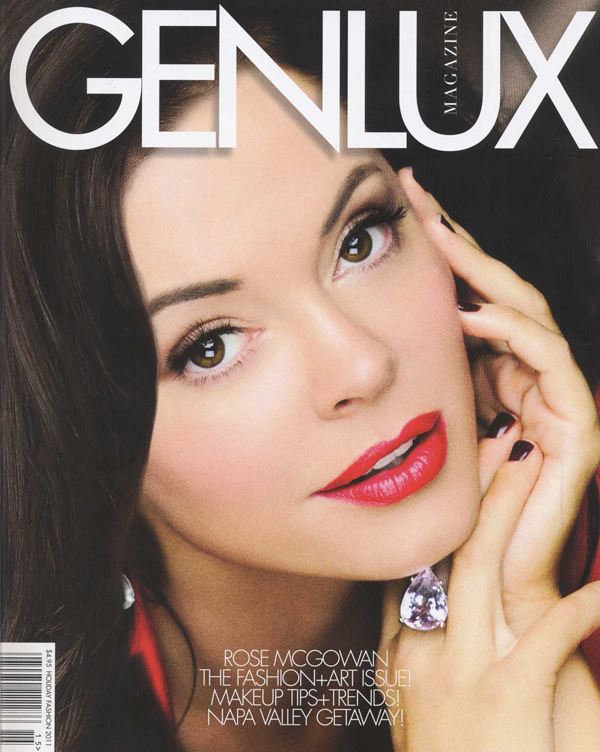
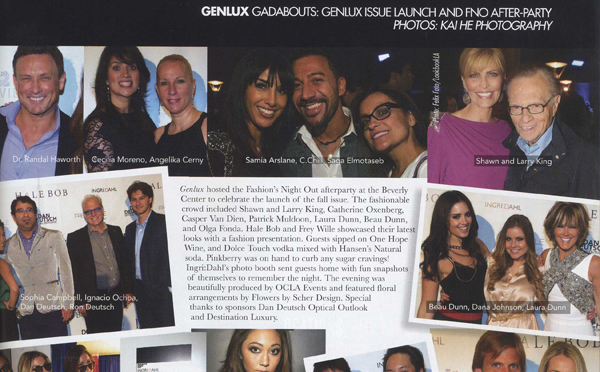
HOLLYWOOD REPORTER (2011) – INSIDE THE EMMY ARMS RACE
To get the look, even those who have been shooting night and day can pull it together fast. Trainers insist even two weeks of work can make a difference. First, forget about the myth that weights bulk up arms. “Weights make your arms firmer and leaner as long as you watch your diet,” say celebrity trainer Ashley Borden. “Two weeks before a red carpet, use a heavier free weight. Triceps on the bottom of arms collect the most body fat, so for every push-up exercise, do two pulldowns.” But for women genetically predisposed to putting on muscle, trainer David Kirsch prefers workout bands. “I would have most clients elongate rather than bulk up.”
Trainer Ramona Braganza also like shoulder accentuation. “Square shoulders are sexy and athletic at the same time,” she says. “I worked with Anne Hathaway a few years back, weeks before the Oscars. We did super sets, one exercise after another on the same muscle.” And designers will tell you that good shoulders help a dress hang well and can make the waist and hips seem slimmer. Adds Borden: “Most people have ‘forward pull’ from leaning shoulders forward, which causes bra fat near your boobs. Work your shoulders helps.”
It’s hard to believe diet affects arm appearance, but it does. “Kill the Diet Coke and alcohol two weeks before,” Borden warns. “Sodium bloats your arms.”
If there’s no time for workouts, there are other things to resort to, like lasers. “The Titan laser will decrease arm circumference in two treatments,” says Beverly Hills dermatologist Peter Kopelson. “You can do it day-of for immediate tightening. Women should also be using lotion with glycolic acid to improve elasticity and texture.” To render a supernova glow to arms, dermatologist David Colbert performs full-body treatments featuring microdermabrasion, milk acid, glucosamine and laser pulse.
With a little more notice, to combat loose skin, Beverly Hills plastic surgeon Randal Haworth is in favor of a brachioplasty, an arm lift. “With a small incision in the armpit, you can take in the skin all the way to the elbow,” he says. Another option is spot liposuction. “Aggressive exercise will help, but not in two weeks. Lipo will do it in two hours,” add Haworth.
There’s a faster, less-expensive remedy: sleeves. Stylist Simone Harouche loves gowns with sleeves. “When done right,” she says, “it can be chic, modern. Nicole Richie wore a gown with kimono sleeves to the 2010 Oscars.”
“Actresses think only strapless is sexy,” says designer Nicole Miller. “An off-the-shoulder style works really well. It’s true; it’s hard to make a long-sleeved gown sexy. But if you have dramatic sleeves, it’s extremely stylish. After all, the bigger the sleeve, the smaller the arm.
HOLLYWOOD REPORTER (2011) – HOLLYWOOD’S NEW PLASTIC SURGERY ALTERNATIVE: THE QUICK-FIX LASERS
Plastic surgery may no longer be a luxury, but it does demand the luxury of time. When you’ve got a shoot date looming, a premiere, a red carpet or a magazine cover shoot, that’s just out of the question. Not to mention a pitch meeting, the network retreat or the Oscars. The newest beauty fixes won’t take a bite out of your schedule, but that doesn’t mean they aren’t real fixes. The options between a facial and a facelift have multiplied many-fold, like 3D movies. The botoxed-frozen-forehead landscape is now a thing of the past. That, and good old shots of Juvederm or Fraxel laser treatments — applied over several months — have been made nearly obsolete by new techniques for applying fillers and a multitude of lasers that do a multitude of things on any body part you can think of.
Prominent Beverly Hills dermatologist Peter Kopelson, whose father Arnold Kopelson produced Platoon, grew up in show business and understands the needs of its players. According to him, the best problem solver these days is a combo of laser treatments with fillers, but the fillers are applied in a whole new way.
“We don’t inject to the dermis anymore,” Kopelson explains. “Now we’re injecting fillers at a deeper level, right above the bone — that is where facial structure lies. We even do this under the eyes. And now Restylane and Juvederm come with lidocaine in them — a painkiller — so it’s not nearly as painful as it sounds. When you inject on this level, fillers last six months to a year and create a better base for the structure of the skin. Sculptra, a new filler and volume enhancer, lasts about two years.
“We’re also injecting in new areas like the temples. A female studio executive recently came in, thinking she might need a facelift for her jowls. All she needed was the right filler. She walked out in a half-hour with no bruises.”
Kopelson’s North Camden Drive office, which caters to actresses young and older, actors and execs, has a variety of new lasers. But his favorite is Smart Pulse ($500 to $1,900, depending on area treated), which no one else in the country has. It’s non-ablative (doesn’t vaporize the surface of the skin, like the mighty CO2 laser), takes three minutes and works well in a series of treatments to produce more collagen in the top layer of the skin. This is one of the new “lunchtime lasers,” which include the Nd:Yag, the Pearl and Titan — they all tighten the skin and make it less blotchy. And you can apply a little makeup and hit the streets right after application. “They’re perfect for before awards shows,” says Kopelson. “These treatments are now as prominent as stylists.”
Randal Haworth, a popular Beverly Hills plastic surgeon on North Bedford Drive, performs plenty of facelifts but has come to learn that “actors and entertainment executives are very busy people. We treat one of the top choreographers in the business; she works from 7 a.m. to midnight, goes on tour with pop stars, is on the set of videos. She barely has a day to recover, let alone weeks. Everything now is designed to have minimum recovery and a precise result. “Too much filler looks freaky,” says Haworth. “The new permanent gel filler Aquamid is actually removable. If a patient doesn’t like the look of her poofed-up cheek or under-eye, we can stick a needle in and pull it out.” The new injection techniques also have a dramatic reduction in bruising because of micro cannula needles — super skinny — that just give little tiny nicks.
“Lots of guys are asking for the ‘Daniel Craig look.’ This one’s especially popular with actors on daytime soaps.” – David Colbert, M.D.
Men are having fast laser treatments, too. Somehow lasers don’t seem as fussy or feminine as actual lifts. “The IPL laser [$350 to $500] is good for men,” notes Haworth. “They can’t wear makeup to cover up, so men are limited to what they can do. This laser gets rid of fine lines and doesn’t give you that white pale look. They make men look refreshed, but still manly.” Bicoastal dermatologist David Colbert, who does pop-up suites in Beverly Hills before awards shows and caters to a staggering number of A-listers, says a Calcium Nature Lift ($5,000) can do that for men. “The 10-minute liquid calcium injection into the jaw line gives immediate square jaws,” says Colbert. “Lots of guys are asking for the ‘Daniel Craig look.’ This one’s especially popular with actors on daytime soaps.”
Another way to tighten the jaw line is by applying either the Titan laser, which heats the collagen and triggers new growth, or the Ulthera, which works on ultrasound waves to tighten skin. Now they’re also being used on arms, knees, above the breasts and hands. “It even works on the neck area,” adds Colbert, who reminds his patients that knobby knees and knotty hands don’t go with smooth young faces. “I just did a major male TV star with the Titan,” says Colbert. “He was red for 15 minutes, then he left. He’ll be back on set tomorrow.”
Colbert actually works on movie sets. Recently, he was on Craig starrer Dream House and Angelina Jolie’s Salt, bringing with him the Gentle Waves machine to apply to actors every morning before they shot. “It’s a low-energy light that gives a soft glow to your face,” explains Colbert. “Some soap operas have bought them — for $15,000 — and had them installed.”
Before Michelle Williams shot the upcoming October cover of Vogue, Colbert gave her a process he invented, called the Triad: a very light micro dermabrasion, followed by a toning laser that administers 5,000 pulses of low-energy light, followed by a flower acid peel ($1,000). “It gives movie stars flawless skin,” says Colbert, who admits he’s done nearly every actor or actress who’s shot a Vogue or Vanity Fair cover in the past two years. With some stars, he’ll add a Rad C facial ($1,200), which follows the Triad with a layer of vitamin C serum that’s also in his Nourish Eye Cream ($110, colbertmd.com). Sienna Miller did this before her scenes in the Vogue doc The September Issue. Colbert also does full-body Triads. “With HD and giant flat screens, the quality of the skin matters more than ever,” he says. “It’s not just about lighting anymore.”
But the mother of all lasers, the CO2 ($4,000 to $4,500), does require at least one week of downtime. According to Haworth and August Denton, a cosmetic injection specialist on Brighton Way in Beverly Hills, it gives one an 80 percent improvement in skin tone and tightening, where most lasers improve about 20 percent. Considered the gold standard for wrinkle removal, it resurfaces skin by damaging the top layers. “You look like you’re in a horror movie for three to five days,” says Haworth, “but after that, the skin heals quickly. You have fewer spots, far fewer brown spots and lines, and it’s great for photography sittings, red carpets and interviews.” Until recently, the downtime for CO2 was two weeks, but new improvements mean you only need to stay home for about a week. There is also a new healing makeup by Oxygentix that can be applied a day after the laser, which promotes healing during recovery and downplays the pinkness, which resembles a sunburn.
And if this weren’t enough, drug companies and researchers are readying new medications that can block inflammation; within a year, healing from an eyelift or facelift will take only a few days. “Doctors don’t want plastic surgery to be obsolete,” one plastic surgeon said off the record. “So they’ve got to find a way to make it quicker. Nobody’s got any patience these days. And you don’t want a lot fewer patients. Right now, we’re losing them to lasers.”
LIFE & STYLE (2011) – EVERYONE WANTS PIPPA’S BUTT!
IN STYLE (2009) – 2009 BEST BEAUTY BUYS
In between tending to Hollywood’s most famous faces (and hair and nails), these experts tested thousands of beauty products to help pick our winners.
Skin Sensitive
100 Acne Regimen
Proactive
The triple threat of cleanser, toner and lotion shows zits no mercy. The secret to its success: prescription-grade benzoyl peroxide, which releases oxygen into pores to eliminate acne-causing bacteria, explains Beverly Hills dermatologist Randal Haworth.
106 Rosacea Treatment
Eucerin Redness Relief SPF 15
The subtle green tint of this fragrance- and oil-free lotion immediately camouflages redness, says L.A. dermatologist Randal Haworth. And it contains sunscreen and licorice root, an anti-inflammatory that calms the skin, add N.Y.C dermatologist Jeannette Graf.
COSMOPOLITAN (2009) – 25 WACKY QUESTIONS ABOUT PLASTIC SURGERY
What’s driving the boom? “It’s gotten cheaper,” says Arthur Perry, MD, author of Straight Talk About Plastic Surgery, “and it’s also more socially acceptable.” And MDs report that females in their 20s are opting for preventative Botox. You probably even know someone who’s had plastic surgery and, with all the buzz, have some questions you’re dying to ask on the subject. Here, what’s true and what’s BS.
Sources: Randal Haworth, MD
